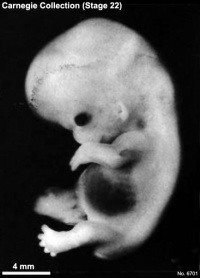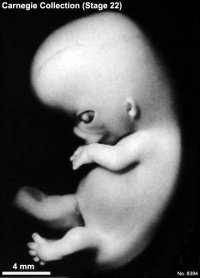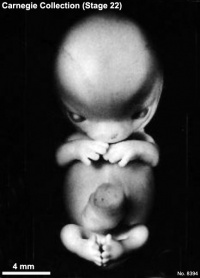1987 Developmental Stages In Human Embryos - Stage 22
| Embryology - 16 Apr 2024 |
|---|
| Google Translate - select your language from the list shown below (this will open a new external page) |
|
العربية | català | 中文 | 中國傳統的 | français | Deutsche | עִברִית | हिंदी | bahasa Indonesia | italiano | 日本語 | 한국어 | မြန်မာ | Pilipino | Polskie | português | ਪੰਜਾਬੀ ਦੇ | Română | русский | Español | Swahili | Svensk | ไทย | Türkçe | اردو | ייִדיש | Tiếng Việt These external translations are automated and may not be accurate. (More? About Translations) |
O'Rahilly R. and Müller F. Developmental Stages in Human Embryos. Contrib. Embryol., Carnegie Inst. Wash. 637 (1987).
| Online Editor Note |
|---|
| O'Rahilly R. and Müller F. Developmental Stages in Human Embryos. Contrib. Embryol., Carnegie Inst. Wash. 637 (1987).
The original 1987 publication text, figures and tables have been altered in formatting, addition of internal online links, and links to PubMed. Original Document - Copyright © 1987 Carnegie Institution of Washington.
|
- 1987 Stages: Introduction | 1 | 2 | 3 | 4 | 5 | 6 | 7 | 8 | 9 | 10 | 11 | 12 | 13 | 14 | 15 | 16 | 17 | 18 | 19 | 20 | 21 | 22 | 23 | References | Appendix 1 | Appendix 2 | Historic Papers | Embryonic Development
| Historic Disclaimer - information about historic embryology pages |
|---|
| Pages where the terms "Historic" (textbooks, papers, people, recommendations) appear on this site, and sections within pages where this disclaimer appears, indicate that the content and scientific understanding are specific to the time of publication. This means that while some scientific descriptions are still accurate, the terminology and interpretation of the developmental mechanisms reflect the understanding at the time of original publication and those of the preceding periods, these terms, interpretations and recommendations may not reflect our current scientific understanding. (More? Embryology History | Historic Embryology Papers) |
Stage 22

|

|

|
| middle row to be added. | ||

|

|

|
Fig. 22-1. Photographs of three embryos belonging to stage 22. The eyes are more than half covered by the eyelids. The limbs have increased in length, and the digits touch or overlap. Top row, No. 6701. Middle row, No. 6832. Bottom row, No. 8394. All views are at the same magnification.
Size And Age
The middle group of embryos of this stage measure 25–27 mm in length.
The age is believed to be approximately 54 postovulatory days.
External Form
The eyelids, which have been thickening gradually, are now rapidly encroaching upon the eyes. The formation of the auricle has progressed noticeably: the tragus and antitragus especially are assuming a more definite form. The superficial vascular plexus of the head extends upward about three-quarters of the way above the eye-ear level. The hands extend further out in front of the body of the embryo, and the fingers of one hand may overlap those of the other.
Features for Point Scores
- Cornea. The cellular invasion of the postepithelial layer is complete centrally in some eyes (Streeter, 1951, fig. 17). A scleral condensation is now definite (Gilbert, 1957).
- Optic nerve. The mesenchyme surrounding the optic nerve forms a definite sheath.
- Cochlear duct. The tip of the duct points “upward” for the second time (fig. 19-6).
- Adenohypophysis. Remnants of the incomplete stalk are present at each end (fig. 19-7).
- Vomeronasal organ. The appearances are intermediate between those of stages 21 and 23 (fig. 19-9).
- Submandibular gland. The duct shows secondary branches. It is practically solid but a suggestion of a lumen can be found in its oral part (fig. 19-10).
- Metanephros. A few large glomeruli are present (fig. 19-12).
- Humerus. Cartilaginous phases 1–4 are still present (Streeter, 1949, figs. 3 and 15–17). The formation of osteoblasts is beginning. A bony collar appears in the humerus, radius, ulna, and femur and tibia during stages 22 and 23 (O’Rahilly and Gardner, 1972).
Additional Features
- Blood vascular system. The aortic arch system has been illustrated by Boyd (1937, fig. 1).
- Heart. Reconstructions of the atrial region were reproduced by Licata (1954, figs. 4 and 5). Chordae tendineae begin to form at stages 22 and 23 (Magovern, Moore, and Hutchins, 1986)[1].
- Paramesonephric ducts. The paramesonephric ducts lie side-by-side caudally and show rostral vertical, middle transverse, and caudal vertical portions.
- Brain. A general view of the organ was given by Hochstetter (1919, fig. 42). The superior and inferior colliculi of the midbrain are indicated by their lamination (Bartelmez and Dekaban, 1962). The epithalamus is individualized by the presence of the sulcus dorsalis. In the hemispheres the cortical plate begins to appear.
References
| Online Editor Note |
|---|
| O'Rahilly R. and Müller F. Developmental Stages in Human Embryos. Contrib. Embryol., Carnegie Inst. Wash. 637 (1987).
The original 1987 publication text, figures and tables have been altered in formatting, addition of internal online links, and links to PubMed. Original Document - Copyright © 1987 Carnegie Institution of Washington.
|
- ↑ <pubmed>3729012</pubmed>
See also <pubmed>2252222</pubmed>
Search Pubmed
- 1987 Stages: Introduction | 1 | 2 | 3 | 4 | 5 | 6 | 7 | 8 | 9 | 10 | 11 | 12 | 13 | 14 | 15 | 16 | 17 | 18 | 19 | 20 | 21 | 22 | 23 | References | Appendix 1 | Appendix 2 | Historic Papers | Embryonic Development
| Historic Disclaimer - information about historic embryology pages |
|---|
| Pages where the terms "Historic" (textbooks, papers, people, recommendations) appear on this site, and sections within pages where this disclaimer appears, indicate that the content and scientific understanding are specific to the time of publication. This means that while some scientific descriptions are still accurate, the terminology and interpretation of the developmental mechanisms reflect the understanding at the time of original publication and those of the preceding periods, these terms, interpretations and recommendations may not reflect our current scientific understanding. (More? Embryology History | Historic Embryology Papers) |
Cite this page: Hill, M.A. (2024, April 16) Embryology 1987 Developmental Stages In Human Embryos - Stage 22. Retrieved from https://embryology.med.unsw.edu.au/embryology/index.php/1987_Developmental_Stages_In_Human_Embryos_-_Stage_22
- © Dr Mark Hill 2024, UNSW Embryology ISBN: 978 0 7334 2609 4 - UNSW CRICOS Provider Code No. 00098G
